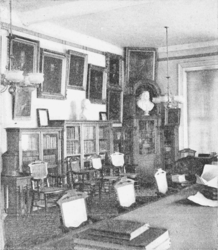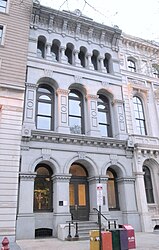American Philosophical Society
American Philosophical Society Hall | |
U.S. National Register of Historic Places | |
 | |
 | |
| Location | 104 S. Fifth St. Philadelphia, Pennsylvania |
|---|---|
| Coordinates | Coordinates: 39°56′55.51″N 75°8′59.42″W / 39.9487528°N 75.1498389°W |
| Built | 1785–89 |
| Architect | Samuel Vaughan |
| Architectural style | Georgian |
| NRHP reference No. | 66000675[1] |
| Significant dates | |
| Added to NRHP | October 15, 1966 |
| Designated NHL | January 12, 1965 |
The American Philosophical Society (APS), founded in 1743 in Philadelphia, is a scholarly organization that promotes knowledge in the sciences and humanities through research, professional meetings, publications, library resources, and community outreach. Considered the first learned society in the United States, it has about 1,000 elected members, and by April 2020 had had only 5,710 members since its creation. Through research grants, published journals, the American Philosophical Society Museum, an extensive library, and regular meetings, the society supports a variety of disciplines in the humanities and the sciences.
Philosophical Hall, now a museum, is just east of Independence Hall in Independence National Historical Park; it was designated a National Historic Landmark in 1965.
History[]
The Philosophical Society, as it was originally called, was founded in 1743 by Benjamin Franklin, James Alexander, Francis Hopkinson, John Bartram, Philip Syng, Jr. and others[2][3] as an offshoot of an earlier club, the Junto.

Early members included: Benjamin Franklin, John Dickinson, George Washington, John Adams, Thomas Jefferson,[4] Alexander Hamilton, James McHenry, Thomas Paine, David Rittenhouse, Peter Stephen Du Ponceau, Nicholas Biddle, Owen Biddle, Benjamin Rush, James Madison, Michael Hillegas, John Marshall, Charles Pettit and John Andrews.
It was common at the time for intellectual societies to invite members from around the world. And so the society recruited members from other countries, including Alexander von Humboldt, the Marquis de Lafayette, Baron von Steuben, Tadeusz Kościuszko, and Princess Dashkova.
The society lapsed into inactivity by 1746, but in 1767 it was revived. On January 2, 1769, it united with the American Society for Promoting Useful Knowledge under the name American Philosophical Society Held at Philadelphia for Promoting Useful Knowledge. Franklin was elected the first president.[5] During this time, the society maintained a standing Committee on American Improvements; one of its investigations was to study the prospects for a canal to connect the Chesapeake Bay and the Delaware River.[6] The Chesapeake and Delaware Canal, which had been proposed by Thomas Gilpin, Sr., was built in the 1820s.[7]

After the American Revolution, the society looked for leadership to Francis Hopkinson, one of the signatories of the United States Declaration of Independence. Under his influence, the society received land from the government of Pennsylvania, along with a plot of land in Philadelphia, where Philosophical Hall now stands.
Charles Darwin, Robert Frost, Louis Pasteur, Elizabeth Cabot Agassiz, John James Audubon, Linus Pauling, Margaret Mead, Maria Mitchell, and Thomas Edison became members of the society.
Many members of the Society of the Cincinnati were among the APS's first board members and contributors; the APS and SOC still maintain an informal, collegial relationship.
Membership[]
Membership of the APS "honors extraordinary accomplishments in all fields". It has about 1,000 elected members, comprising about 840 "resident" members (United States citizens or those working or living in the United States) and about 160 "international" members. As of April 2020 it had elected 5,710 members in all since its foundation.[8]
Awards[]
In 1786, the society established the Magellanic Premium, a prize for achievement in "navigation, astronomy, or natural philosophy," the oldest scientific prize awarded by an American institution, which it still awards. Other awards include the Barzun Prize for cultural history, the Judson Daland Prize for Outstanding Achievement in Clinical Investigation, the Benjamin Franklin Medal, the Lashley Award for neurobiology, the Lewis Award, and the Thomas Jefferson Medal for distinguished achievement in the arts, humanities, or social sciences.
Publications, archive[]
The APS has published the Transactions of the American Philosophical Society since 1771. Five issues appear each year. The Proceedings have appeared since 1838; they publish the papers delivered at the society's biannual meetings. The society has also published the collected papers of Benjamin Franklin, Joseph Henry, William Penn, and Meriwether Lewis and William Clark. Jane Aitken bound 400 volumes for the society.[9]
The society also has an expansive archive on framer of the U.S. constitution John Dickinson.[10]
Buildings[]

Philosophical Hall[]
Philosophical Hall, at 104 South Fifth Street, Philadelphia, between Chestnut and Walnut Streets, immediately south of Old City Hall, was built in 1785–89 to house the society and designed by Samuel Vaughan in the Federal style.[11][12] A third floor was added in 1890 to accommodate the expanding library, but was removed in 1948–50,[12] when the building was restored to its original appearance for the creation of Independence National Historical Park.[13] In 2001, it was opened to the public as The American Philosophical Society Museum, hosting revolving, thematic exhibitions that explore intersections of history, art, and science. The museum features works of art, scientific instruments, original manuscripts, rare books, natural history specimens, and curiosities of all kinds from the APS's own collections, along with objects on loan from other institutions.[14]
Library Hall[]

In 1789–90, the Library Company of Philadelphia (LCP) built its headquarters directly across 5th Street from APS. In 1884 LCP sold its building, which was demolished for the expansion of the Drexel & Company Building in 1887. This building was demolished in the mid-1950s, during the creation of Independence National Historical Park.
APS built a library on the site in 1958 and recreated the façade of the old LCP building.
Benjamin Franklin Hall[]
APS restored the former Farmers' & Mechanics' Bank building at 425–29 Chestnut Street, which was built in 1854–55 to the design of John M. Gries in the Italianate style,[15] to serve as a lecture hall. It is the site of meetings and most major events the society hosts.[16]
Richardson Hall[]
Constance C. and Edgar P. Richardson Hall at 431 Chestnut Street, immediately west of Benjamin Franklin Hall, is the former Pennsylvania Company for Insurances on Lives and Granting Annuities Building, which was built in 1871–73 and designed by Addison Hutton.[17] It contains offices and the Consortium for History of Science, Technology and Medicine.[16]
Gallery[]

Interior of Philosophical Hall
(c. 1901–02)
Benjamin Franklin Hall
(2013)
Richardson Hall
(2013)
References[]
Citations[]
- ^ "National Register Information System – (#66000675)". National Register of Historic Places. National Park Service. January 23, 2007.
- ^ Duer, William Alexander. The life of William Alexander, Earl of Stirling, Major-General in the Army of the United States during the Revolution New York: Wiley & Putnam for the New Jersey Historical Society, 1847. p.5
- ^ "Philip Syng, Jr.", Philadelphia Museum of Art. Retrieved 31 December 2015.
- ^ "American Philosophical Society selected records, 1784–1954". Archives of American Art. 2011. Retrieved June 17, 2011.
- ^ New International Encyclopedia
- ^ Goodrich, Carter (1974). Government Promotion of American Canals and Railroads, 1800–1890. Greenwood Press. ISBN 978-0837177731.
- ^ Kozel, Scott M. (2010). "Chesapeake and Delaware Canal (C & D Canal)". PENNWAYS: Roads to the Future. Scott M. Kozel. Archived from the original on May 13, 2015. Retrieved September 6, 2012.
- ^ "Elected Members". American Philosophical Society. Retrieved July 12, 2021.
- ^ James 1971, p. 26.
- ^ "John H. Powell Collection of John Dickinson Research". American Philosophical Society. Retrieved May 26, 2020.
- ^ Gallery, John Andrew, ed. (2004), Philadelphia Architecture: A Guide to the City (2nd ed.), Philadelphia: Foundation for Architecture, ISBN 0962290815 p.160
- ^ Jump up to: a b Teitelman, Edward & Longstreth, Richard W. (1981), Architecture in Philadelphia: A Guide, Cambridge, Massachusetts: MIT Press, ISBN 0262700212, p. 30
- ^ Richard Webster, Philadelphia Preserved (Philadelphia: Temple University Press, 1976), p. 92.
- ^ "American Philosophical Society Museum: About". ARTINFO. 2008. Retrieved July 25, 2008. Cite journal requires
|journal=(help)[permanent dead link] - ^ Gallery, John Andrew, ed. (2004), Philadelphia Architecture: A Guide to the City (2nd ed.), Philadelphia: Foundation for Architecture, ISBN 0962290815, pp. 55–56
- ^ Jump up to: a b "Directions" Archived 2013-06-04 at the Wayback Machine on the APS website
- ^ Gallery, John Andrew, ed. (2004), Philadelphia Architecture: A Guide to the City (2nd ed.), Philadelphia: Foundation for Architecture, ISBN 0962290815, p.64
Sources[]
- Works cited
- James, Edward T. (1971). Notable American Women, 1607–1950: A Biographical Dictionary. Harvard University Press. p. 26. ISBN 978-0-674-62734-5.
External links[]
| Wikimedia Commons has media related to American Philosophical Society. |
| Wikisource has the text of a 1920 Encyclopedia Americana article about The American Philosophical Society. |
- Official website
- American Philosophical Society at the Indiana Philosophy Ontology Project
- American Philosophical Society publications
- Notes on the American Philosophical Society from the Scholarly Societies project
(Wayback Machine copy)
- Historic American Buildings Survey (HABS) No. PA-1464, "American Philosophical Society"
- Listing of Philosophical Hall at Philadelphia Architects and Buildings
- "Writings of Benjamin Franklin", broadcast from the American Philosophical Society from C-SPAN's American Writers
- Libraries in Philadelphia
- Museums in Philadelphia
- Old City, Philadelphia
- Learned societies of the United States
- Members of the American Philosophical Society
- Philosophical societies in the United States
- Organizations based in Philadelphia
- 1743 establishments in Pennsylvania
- Benjamin Franklin
- History of Philadelphia








